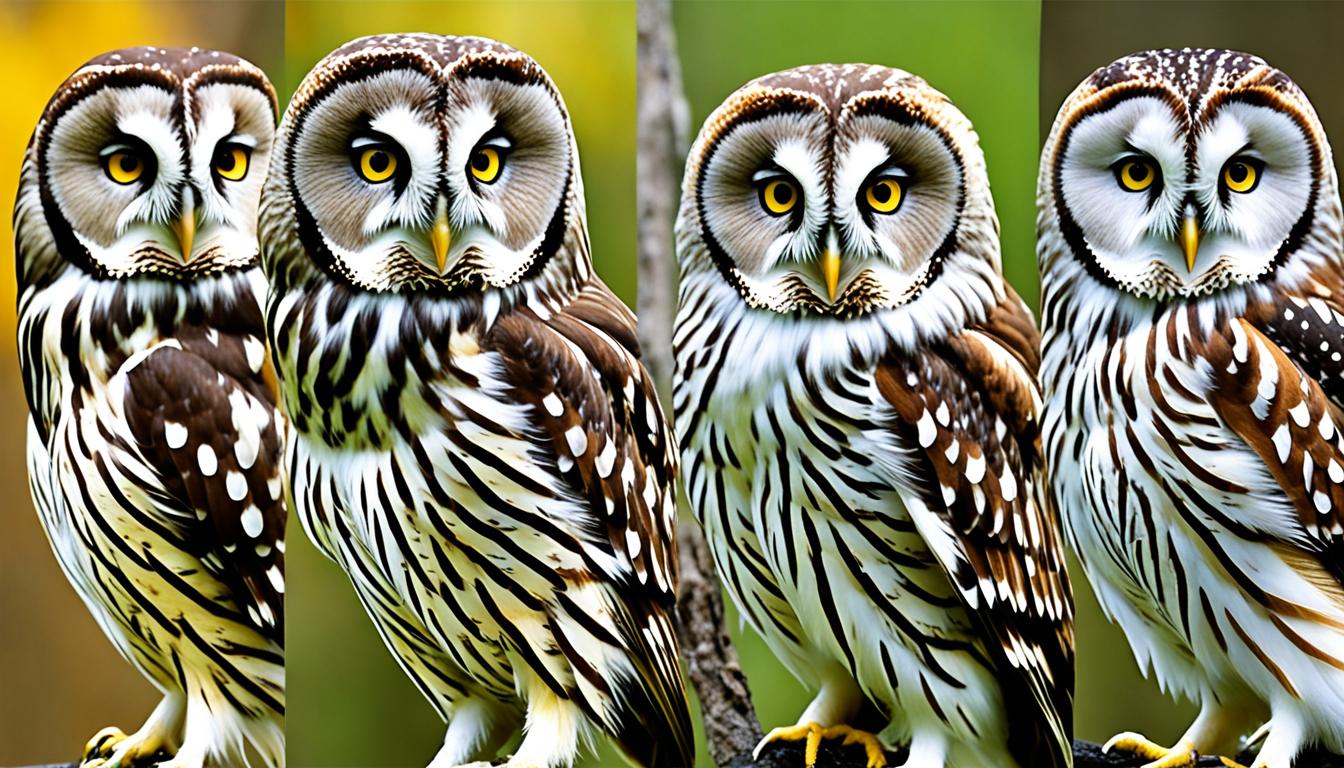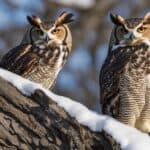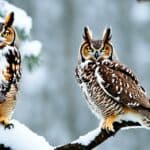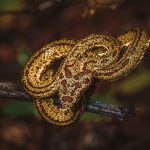Have you ever wondered how bird watchers tell the many owl species in the US apart? They do this despite owls being mostly active at night and hiding away. They spot owls like the tiny Elf Owl or the impressive Great Gray Owl.
To really see these captivating birds, bird watchers look at their size, what colors they are, and where they live. This info is vital not only for people who love birds but for saving them too. Groups like the American Bird Conservancy work hard to protect birds from dangers like losing their homes, getting hurt by chemicals, and being hit by cars. So, knowing and naming owl types is super important now.
Understanding Owl Identification Basics
Spotting different owl types means looking at key features. These include ear tufts, size, and even the color of their eyes. Paying attention to these details helps tell owls apart among their many variations.
Ear Tufts
Ear tufts stand out in owl identification. They are critical since not all owls have them. For instance, the Barn Owl is without, unlike the Great Horned Owl with its clear tufts.
Size
Comparing sizes is important in recognizing owls. From tiny Elf Owls to the massive Great Gray Owl, their size varies greatly. This makes distinguishing them easier by seeing how they measure up against other birds.
Eye and Bill Color
The color of an owl’s eyes and bill are key clues. For example, a Snowy Owl’s bright yellow eyes are striking against a Northern Spotted Owl’s dark eyes. Similar differences in bill color help in spotting different species.
Plumage Color
Feather colors and patterns are unique to each owl. The Snowy Owl features plain white feathers, while the Barred Owl has distinct markings. This makes their outer appearance vital in telling them apart.
Time of Day
Knowing when they are active helps too. Owls are mainly active at night or during dusk and dawn. This habit can point you toward certain owl species.
Hunting Behavior
Watching how an owl hunts can also aid in identification. The Barn Owl flies low over fields to catch prey. Meanwhile, the Great Horned Owl likes pouncing from perches. Understanding these hunting habits is informative.
Habitat
Owls live in various places, from forests to open fields. Recognizing where they prefer to dwell can be a big clue. For example, the Burrowing Owl likes the open while the Barred Owl chooses dense forests.
Distribution Maps
Looking at distribution maps can guide you. These maps show where certain owl species are commonly found. This way, you can match owls to their usual locations.
Vocalizations
Owl sounds are very distinct. Each owl has its own call, from the deep hoots of the Great Horned Owl to the shrill cries of the Eastern Screech Owl. Learning these calls is a great way to identify them.
Barn Owl: The Heart-faced Raptor
The Barn Owl stands out with its heart-shaped face among North American owls. This feature helps them hear very well, making them great hunters. It’s important to know how to identify Barn Owls for bird lovers and scientists.
Physical Description
Identifying Barn Owls is easy because of their unique looks. They have a white, heart-shaped face and big, dark eyes. Their feathers are a mix of white and gold, with spots of black throughout. These owls also have a noticeable wingspan of 31 to 37 inches, aiding in their graceful flight.
Distribution and Habitat
Barn Owls live in many places across North America. You can find them in grasslands, deserts, and farm fields, where mice and other small animals are common. They are good at living in different homes, which helps their number grow. The U.S. and Canada have about 120,000 of them, showing their population is doing well.
Behavior and Hunting
Barn Owls are skilled hunters, able to find food in the dark because of their sharp hearing. They hunt from low perches or fly over open areas. Their main foods are small mammals, like mice and voles. But they also eat birds or insects if needed.
Barred Owl: Recognizing the ‘Hooting’ Owl
The Barred Owl is known for its loud hoots. Learning these hoots can help you identify this owl. Its voice is its key feature.
In the 20th century, Barred Owls have grown in number and spread out. There are now about 3,200,000 of them in the U.S. and Canada. Their increase shows how well they adapt and cover different areas in North America.
These owls like to live in forests that are old and mixed. Since these kinds of forests are common, Barred Owls are not hard to find.
To know Barred Owls better, check out detailed owl guides. These guides talk about their looks and actions. They also help you understand how Barred Owls affect their forest homes.
“The Barred Owl’s hooting call is so distinctive that bird enthusiasts often learn to recognize it before they ever see the bird in the wild.”
Below is a table to help you recognize Barred Owls quickly. It lists their important traits and favorite places to live. This information is crucial in any owl identification guide:
| Characteristic | Description |
|---|---|
| Vocalization | Series of emphatic hoots |
| Population | 3,200,000 in U.S. and Canada |
| Habitat | Mixed, mature forests |
| Range Expansion | Dramatic increase in the 20th century |
How do you identify different species of owls in the USA?
Figuring out the types of owls in the United States is tricky because they are hard to find and look different. By paying close attention and knowing key details, you can tell one owl from another. Let’s look at what to focus on:
1. Size
From the tiny Elf Owl to the big Great Gray Owl, owls come in various sizes. It helps to compare an owl’s size with more common birds at first glance.
2. Plumage Color
Owls can be white as snow or as dark as the night. Spotting patterns and shades will steer you to the right owl type.
3. Eye Color
Looking at an owl’s eye color is also critical. For example, Snowy Owls have yellow eyes, but the Barn Owl’s are a deep brown.
“The eyes of an owl are key to identification. They can tell you a lot about the species you’re observing.”
Every owl has its own unique call. Knowing these sounds is very useful for finding who’s hooting at night.
It’s also important to know the habitats and behaviors of owls in the U.S. For example, Barred Owls like mixed forests, while Burrowing Owls make their homes in grassy areas.
Common Owl Species in the USA
| Owl Species | Key Identification Features |
|---|---|
| Barn Owl | Heart-shaped face, white underparts, yellowish to gray upperparts |
| Barred Owl | Large size, brown eyes, vertical bars on chest |
| Great Horned Owl | Large ear tufts, yellow eyes, mottled gray-brown plumage |
| Snowy Owl | White plumage, black spots, yellow eyes |
| Burrowing Owl | Small size, long legs, spotted brown and white plumage |
Burrowing Owl: Life Underground
The Burrowing Owl stands out due to its unique traits and behaviors. By learning about its looks, where it lives, and what it does, you can spot this owl easily.
Physical Description and Size
The Burrowing Owl is small and stands about 7.5 to 10 inches tall. It differs from other owls with its long legs and no ear tufts. Look for its brown feathers with white dots and bright yellow eyes.
Habitat and Distribution
These owls hang out in open areas like grasslands and deserts. They sleep in burrows, sometimes taking over homes of prairie dogs. They live throughout North and South America. But their numbers are going down. About 1,100,000 are in the U.S. and Canada.
Behavioral Traits
Burrowing Owls are unique because they’re active in the daytime. This makes them stand out from other owl types. They search for food on the ground, looking for bugs and small animals.
Great Horned Owl: The Mighty Predator
The Great Horned Owl is a strong player in the bird world. It stands out with its power and adaptability. You can find them in forests, swamps, deserts, and even cities, where they hunt well. Knowing where they live helps us spot them among other birds.
What makes the Great Horned Owl unique is its wide diet. It hunts not just smaller creatures but also birds of prey. With sharp senses and silent flights, this owl is very successful at hunting. Learning how they hunt helps us tell them apart from other owls.
Even though they are very adaptable, the number of Great Horned Owls is going down. There are about 3,900,000 left in the U.S. and Canada. We need to work hard to keep their numbers up. Understanding their needs and homes is key to protecting these amazing birds.
Snowy Owl: The Arctic Visitor
The Snowy Owl is known for its stunning white look and bright yellow eyes. It usually stays in the Arctic but can fly south into parts of the United States. This happens during the winter.
Unique Features
Spotting a Snowy Owl is quite easy due to its size and color. They are very large with mostly white feathers. Some have black or brown marks. The thick feathers and feathered feet help them survive in the cold.
Seasonal Movements
Snowy Owls move around a lot, looking for food. In winter, they can fly further south than usual. This takes them to places in Canada and the Northern U.S. Their movement is closely tied to the number of lemmings available.
Vocalization and Behavior
Snowy Owls’ sounds are unique among owls. They can make deep hoots and other sounds for different reasons. These include mating and protecting their territory. They also usually hunt during the day, unlike most owls who are active at night.
Knowing about Snowy Owls makes seeing them even more special. They are nature’s amazing visitors from the Arctic.
Eastern and Western Screech Owls: The Tiny Titans
Screech Owls are truly beloved in the United States. They’re adored for their small size and interesting behaviors. Now, let’s take a closer look at the Eastern and Western Screech Owls. We’ll explore what makes them different, especially in looks and where they live.
Physical Differences
It’s important to notice how the Eastern and Western Screech Owls look different. The Eastern ones can be gray or reddish-brown. Meanwhile, the Western ones seem more of a simple gray or brown. But, they do both have tufts of feathers on their heads.
Habitat Preferences
Where they hang out also helps tell them apart. Eastern Screech Owls like places with lots of trees. This includes areas with houses and fruit trees. On the other hand, Western Screech Owls prefer more open spaces like woods with fewer trees. They also do well in dry places like deserts and even in cities sometimes. Knowing their favorite places is key to spotting them in the wild.
| Feature | Eastern Screech Owl | Western Screech Owl |
|---|---|---|
| Primary Color Morphs | Gray, Reddish-brown | Gray, Brown |
| Typical Habitat | Deciduous forests, Suburban, Orchards | Open woodlands, Desert, Urban |
| Head Tufts | Present | Present |
Conservation Efforts for American Owls
Owls in North America face many challenges, from losing their homes to being harmed by pesticides. Humans also disturb them. To help, many people are working hard to protect owls and the places they live.
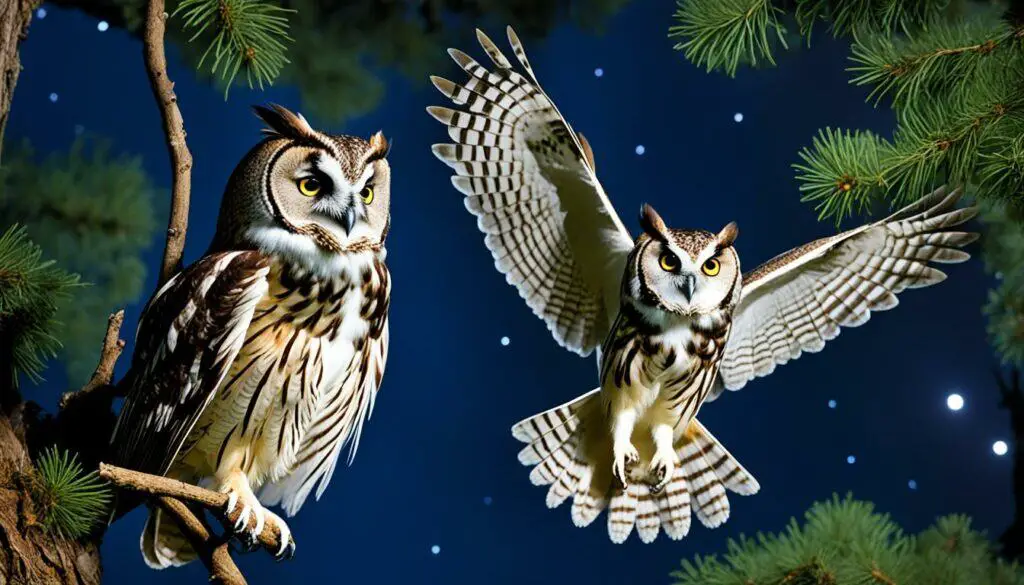
Protecting owl habitats is a major focus. It’s vital to save the forests, wetlands, and grasslands where North American owls live. Efforts to stop harmful pesticides are strong too.
Stopping people from bothering owls is also important. This means making laws against hunting them and using their lands carefully.
Getting the community involved is key as well. There are campaigns to teach people about owls and to get them involved in helping. This way, everyone works together to protect these amazing birds.
All these efforts together give us hope. By working hard and working together, we can make sure owls will always have a place in our world.
Effective Owl Watching Tips
Starting your owl watching adventure can bring great joy, though you need to be prepared and patient. Knowing where and when to look will help you see these majestic birds.
Useful tools like binoculars are essential for watching owls from afar. A field guide will help you identify them by their looks and sounds. Knowing their calls is key since owls are often heard before seen. The Merlin Bird ID app from Cornell can help you learn these sounds.
Timing is everything. Owls are most active at night, so early morning or late evening is best to spot them. At these times, you may see them start their hunt. Remember, being patient and staying quiet increases your chances of seeing these incredible birds. Use these strategies to improve your owl watching skills and spot more owls.
FAQ
How do you identify different species of owls in the USA?
Identifying owl species in the USA means looking for things like size and color. This includes ear tufts, eye and bill color, and how they sound. Knowing where they like to live and checking maps can also be helpful.
What are the key characteristics to look for in owl species identification?
Look for features like ear tufts, size, and eye colors. Also, pay attention to the color of their feathers and when they are most active. Their behavior when hunting and where they live are important clues.
Can owl vocalizations help in recognizing American owls?
Yes, the sounds owls make are different for each species. Knowing their calls can help you figure out which owl is which.
What distinguishes the Barn Owl from other owl species?
The Barn Owl stands out with its heart-shaped face and love for quiet sounds. It likes grasslands, deserts, and fields. Plus, its pale feathers make it easy to spot.
What should I know about the Barred Owl for proper identification?
The Barred Owl’s hoot is famous and it likes mature forests. Look for its big, round head, dark eyes, and the bars on its feathers. These are key signs it’s a Barred Owl.
How can I recognize the Burrowing Owl?
Spot the Burrowing Owl by its small size and long legs. It lives in burrows underground. You might see it hunting on the ground in grassy areas during the day.
What are the notable features of the Great Horned Owl?
The Great Horned Owl is big and eats other birds of prey. It has cool ear tufts and you can find it almost anywhere. This makes it a top predator.
What makes the Snowy Owl unique among American owls?
The Snowy Owl is hard to miss in its all-white feathers. Its yellow eyes stand out too. They come to the Arctic to breed, and their calls and movements are special.
How do Eastern and Western Screech Owls differ?
Eastern and Western Screech Owls have different looks and homes. They match in size and stay with one mate. But, their colors and sounds change depending on the area.
What conservation efforts are in place for American owl species?
To protect American owls, efforts focus on saving their homes and stopping harmful chemicals. Stronger rules are also being made to keep owl populations healthy in North America.
What tips can enhance my owl-watching experience?
To make owl-watching better, learn about where owls live and how they act. Bring patience and tools like binoculars and guides. This will make your owl-watching adventure more fun.

